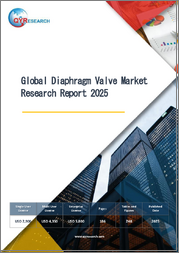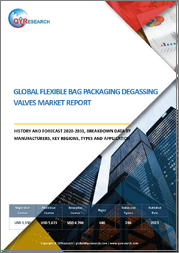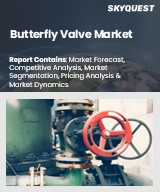
|
시장보고서
상품코드
1721239
세계의 감압 밸브 시장 조사 보고서 : 산업 분석, 규모, 점유율, 성장, 동향, 예측(2025-2033년)Global Pressure Reducing Valve Market Research Report- Industry Analysis, Size, Share, Growth, Trends and Forecast 2025 to 2033 |
||||||
세계의 감압 밸브 시장 규모는 2024년 40억 4,000만 달러에서 2033년에는 61억 2,000만 달러로 성장하며, 2026-2033년의 예측 기간 중 4.73%의 견고한 연평균 성장률(CAGR)을 보일 것으로 예측됩니다.
감압 밸브 시장은 산업계가 유체 제어 시스템의 안전성과 효율성을 점점 더 우선시함에 따라 크게 성장할 준비가 되어 있습니다. 이 밸브는 상수도, 석유 및 가스, 화학 처리 등 다양한 용도에서 압력 수준을 조절하는 데 중요한 역할을 합니다. 규제 기준이 더욱 엄격해짐에 따라 최적의 성능과 안전성을 보장하는 신뢰할 수 있는 감압 밸브에 대한 수요가 증가할 것으로 예측됩니다. 밸브의 설계 및 재료 혁신은 내구성과 응답성을 강화하여 다양한 분야에서 시스템의 무결성과 운영 효율성을 유지하는 데 필수적인 구성 요소로 자리매김하고 있습니다.
또한 감압 밸브에 스마트 기술을 통합하는 것은 시장 전망을 바꾸고 있으며, IoT 지원 장비의 출현으로 압력 레벨의 실시간 모니터링 및 제어, 예측 정비가 가능하여 시스템 고장의 위험을 줄일 수 있습니다. 이러한 기술적 진보는 업무 효율성을 향상시킬 뿐만 아니라 기업의 비용 절감에도 기여하고 있습니다. 산업계가 공정 최적화와 다운타임 최소화를 추구함에 따라 스마트 기능을 갖춘 고급 감압 밸브에 대한 수요가 급증하고 시장의 추가 혁신을 촉진할 가능성이 높습니다.
지속가능성에 대한 전 세계의 관심이 높아짐에 따라 감압 밸브 시장도 환경 문제를 해결하기 위해 적응하고 있습니다. 산업계가 이산화탄소 배출량을 줄이기 위해 노력하면서 친환경 소재와 에너지 효율적인 설계의 개발이 점점 더 중요해지고 있습니다. 또한 물 절약과 자원 관리에 대한 관심이 높아지면서 지방 자치 단체의 상수도 시스템에서 감압 밸브의 채택이 촉진되고 있습니다. 이 시장의 미래는 기술 혁신, 지속가능성 및 성능 향상에 대한 헌신으로 특징 지워지며, 감압 밸브가 진화하는 산업 환경에서 효율적인 유체 제어 시스템에 필수적인 요소로 남을 수 있도록 보장합니다.
목차
제1장 서문
제2장 개요
- 시장의 하이라이트
- 세계 시장 스냅숏
제3장 감압 밸브 : 산업 분석
- 서론 - 시장 역학
- 시장 성장 촉진요인
- 시장 성장 억제요인
- 시장 기회
- 업계 동향
- Porter's Five Forces 분석
- 시장의 매력 분석
제4장 밸류체인 분석
- 밸류체인 분석
- 원재료 분석
- 원재료 리스트
- 원재료 제조업체 리스트
- 주요 원재료의 가격 동향
- 잠재적 바이어 리스트
- 마케팅 채널
- 다이렉트 마케팅
- 인다이렉트 마케팅
- 마케팅 채널 발전 동향
제5장 세계의 감압 밸브 시장 분석 : 유형별
- 개요 : 유형별
- 유형별 : 실적 데이터와 예측 데이터 분석
- 직동식 감압 밸브
- 파일럿식 감압 밸브
제6장 세계의 감압 밸브 시장 분석 : 작동 압력별
- 개요 : 작동 압력별
- 작동 압력별 : 실적 데이터와 예측 데이터 분석
- 300Psig 미만
- 301-600Psig
- 600Psig 이상
제7장 세계의 감압 밸브 시장 분석 : 최종사용자별
- 개요 : 최종사용자별
- 최종사용자별 : 실적 데이터와 예측 데이터 분석
- 석유 및 가스
- 발전
- 화학
- 상하수도
- 금속·광업
- 기타
제8장 세계의 감압 밸브 시장 분석 : 지역별
- 지역별 전망
- 서론
- 북미의 판매 분석
- 개요, 실적과 예측
- 북미 : 부문별
- 북미 : 국가별
- 미국
- 캐나다
- 멕시코
- 유럽의 판매 분석
- 개요, 실적과 예측
- 유럽 : 부문별
- 유럽 : 국가별
- 영국
- 프랑스
- 독일
- 이탈리아
- 러시아
- 기타 유럽
- 아시아태평양의 판매 분석
- 개요, 실적과 예측
- 아시아태평양 : 부문별
- 아시아태평양 : 국가별
- 중국
- 인도
- 일본
- 한국
- 호주
- 동남아시아
- 기타 아시아태평양
- 라틴아메리카의 판매 분석
- 개요, 실적과 예측
- 라틴아메리카 : 부문별
- 라틴아메리카 : 국가별
- 브라질
- 아르헨티나
- 페루
- 칠레
- 기타 라틴아메리카
- 중동 및 아프리카의 판매 분석
- 개요, 실적과 예측
- 중동 및 아프리카 : 부문별
- 중동 및 아프리카 : 국가별
- 사우디아라비아
- 아랍에미리트
- 이스라엘
- 남아프리카공화국
- 기타 중동 및 아프리카
제9장 감압 밸브 기업의 경쟁 구도
- 감압 밸브 시장의 경쟁
- 제휴·협력·합의
- 합병·인수
- 신제품 발매
- 기타 개발
제10장 기업 개요
- 상위 기업의 시장 점유율 분석
- 시장 집중도
- Aalberts Industries N.V.
- Mueller Water Products Inc.
- Eaton Corporation Plc
- Parker-Hannifin Corporation
- Reliance Worldwide Corporation Limited
- Spirax-Sarco Engineering Plc
- Watts Water Technologies Inc.
- KSB SE & Co. KGaA
- Honeywell International Inc.
- TALIS Management Holding GmbH
Global Pressure Reducing Valve Market size is anticipated to grow from USD 4.04 Billion in 2024 to USD 6.12 Billion by 2033, showcasing a robust Compound Annual Growth Rate (CAGR) of 4.73% during the forecast period of 2026 to 2033.
The pressure reducing valve market is poised for significant growth as industries increasingly prioritize safety and efficiency in fluid control systems. These valves play a crucial role in regulating pressure levels within various applications, including water supply, oil and gas, and chemical processing. As regulatory standards become more stringent, the demand for reliable pressure reducing valves that ensure optimal performance and safety is expected to rise. Innovations in valve design and materials are enhancing durability and responsiveness, making these components essential for maintaining system integrity and operational efficiency across diverse sectors.
Moreover, the integration of smart technologies into pressure reducing valves is transforming the market landscape. The advent of IoT-enabled devices allows for real-time monitoring and control of pressure levels, enabling predictive maintenance and reducing the risk of system failures. This technological advancement not only enhances operational efficiency but also contributes to significant cost savings for businesses. As industries seek to optimize their processes and minimize downtime, the demand for advanced pressure reducing valves equipped with smart features is likely to surge, driving further innovation in the market.
As the global focus on sustainability intensifies, the pressure reducing valve market is also adapting to meet environmental challenges. The development of eco-friendly materials and energy-efficient designs is becoming increasingly important as industries strive to reduce their carbon footprints. Additionally, the growing emphasis on water conservation and resource management is propelling the adoption of pressure reducing valves in municipal water systems. The future of this market is characterized by a commitment to innovation, sustainability, and enhanced performance, ensuring that pressure reducing valves remain integral to efficient fluid control systems in an evolving industrial landscape.
Our reports are meticulously crafted to provide clients with comprehensive and actionable insights into various industries and markets. Each report encompasses several critical components to ensure a thorough understanding of the market landscape:
Market Overview: A detailed introduction to the market, including definitions, classifications, and an overview of the industry's current state.
Market Dynamics: In-depth analysis of key drivers, restraints, opportunities, and challenges influencing market growth. This section examines factors such as technological advancements, regulatory changes, and emerging trends.
Segmentation Analysis: Breakdown of the market into distinct segments based on criteria like product type, application, end-user, and geography. This analysis highlights the performance and potential of each segment.
Competitive Landscape: Comprehensive assessment of major market players, including their market share, product portfolio, strategic initiatives, and financial performance. This section provides insights into the competitive dynamics and key strategies adopted by leading companies.
Market Forecast: Projections of market size and growth trends over a specified period, based on historical data and current market conditions. This includes quantitative analyses and graphical representations to illustrate future market trajectories.
Regional Analysis: Evaluation of market performance across different geographical regions, identifying key markets and regional trends. This helps in understanding regional market dynamics and opportunities.
Emerging Trends and Opportunities: Identification of current and emerging market trends, technological innovations, and potential areas for investment. This section offers insights into future market developments and growth prospects.
SEGMENTATION COVERED IN THE REPORT
By Type
- Direct-acting pressure reducing valve
- Pilot-operated pressure reducing valve
By Operating Pressure
- Below 300 Psig
- 301-600 Psig
- Above 600 Psig
By End-user
- Oil & Gas
- Power Generation
- Chemical
- Water & Wastewater
- Metals & Mining
- Others
- COMPANIES PROFILED
- Aalberts Industries N.V.
- Mueller Water Products Inc.
- Eaton Corporation plc
- Parker-Hannifin Corporation
- Reliance Worldwide Corporation Limited
- Spirax-Sarco Engineering plc
- Watts Water Technologies Inc.
- KSB SE & Co. KGaA
- Honeywell International Inc.
- TALIS Management Holding GmbH
- The above list can be customized.
TABLE OF CONTENTS
1. PREFACE
- 1.1. Report Description
- 1.1.1 Objective
- 1.1.2 Target Audience
- 1.1.3 Unique Selling Proposition (USP) & offerings
- 1.2. Research Scope
- 1.3. Research Methodology
- 1.3.1 Market Research Process
- 1.3.2 Market Research Methodology
2. EXECUTIVE SUMMARY
- 2.1. Highlights of Market
- 2.2. Global Market Snapshot
3. PRESSURE REDUCING VALVE INDUSTRY ANALYSIS
- 3.1. Introduction - Market Dynamics
- 3.2. Market Drivers
- 3.3. Market Restraints
- 3.4. Opportunities
- 3.5. Industry Trends
- 3.6. Poerter's Five Force Analysis
- 3.7. Market Attractiveness Analysis
- 3.7.1 Market Attractiveness Analysis By Type
- 3.7.2 Market Attractiveness Analysis By Operating Pressure
- 3.7.3 Market Attractiveness Analysis By End-user
- 3.7.4 Market Attractiveness Analysis By Region
4. VALUE CHAIN ANALYSIS
- 4.1. Value Chain Analysis
- 4.2. Raw Material Analysis
- 4.2.1 List of Raw Materials
- 4.2.2 Raw Material Manufactures List
- 4.2.3 Price Trend of Key Raw Materials
- 4.3. List of Potential Buyers
- 4.4. Marketing Channel
- 4.4.1 Direct Marketing
- 4.4.2 Indirect Marketing
- 4.4.3 Marketing Channel Development Trend
5. GLOBAL PRESSURE REDUCING VALVE MARKET ANALYSIS BY TYPE
- 5.1. Overview By Type
- 5.2. Historical and Forecast Data Analysis By Type
- 5.3. Direct-acting pressure reducing valve Historic and Forecast Sales By Regions
- 5.4. Pilot-operated pressure reducing valve Historic and Forecast Sales By Regions
6. GLOBAL PRESSURE REDUCING VALVE MARKET ANALYSIS BY OPERATING PRESSURE
- 6.1. Overview By Operating Pressure
- 6.2. Historical and Forecast Data Analysis By Operating Pressure
- 6.3. Below 300 Psig Historic and Forecast Sales By Regions
- 6.4. 301-600 Psig Historic and Forecast Sales By Regions
- 6.5. Above 600 Psig Historic and Forecast Sales By Regions
7. GLOBAL PRESSURE REDUCING VALVE MARKET ANALYSIS BY END-USER
- 7.1. Overview By End-user
- 7.2. Historical and Forecast Data Analysis By End-user
- 7.3. Oil & Gas Historic and Forecast Sales By Regions
- 7.4. Power Generation Historic and Forecast Sales By Regions
- 7.5. Chemical Historic and Forecast Sales By Regions
- 7.6. Water & Wastewater Historic and Forecast Sales By Regions
- 7.7. Metals & Mining Historic and Forecast Sales By Regions
- 7.8. Others Historic and Forecast Sales By Regions
8. GLOBAL PRESSURE REDUCING VALVE MARKET ANALYSIS BY GEOGRAPHY
- 8.1. Regional Outlook
- 8.2. Introduction
- 8.3. North America Sales Analysis
- 8.3.1 Overview, Historic and Forecast Data Sales Analysis
- 8.3.2 North America By Segment Sales Analysis
- 8.3.3 North America By Country Sales Analysis
- 8.3.4 United States Sales Analysis
- 8.3.5 Canada Sales Analysis
- 8.3.6 Mexico Sales Analysis
- 8.4. Europe Sales Analysis
- 8.4.1 Overview, Historic and Forecast Data Sales Analysis
- 8.4.2 Europe By Segment Sales Analysis
- 8.4.3 Europe By Country Sales Analysis
- 8.4.4 United Kingdom Sales Analysis
- 8.4.5 France Sales Analysis
- 8.4.6 Germany Sales Analysis
- 8.4.7 Italy Sales Analysis
- 8.4.8 Russia Sales Analysis
- 8.4.9 Rest Of Europe Sales Analysis
- 8.5. Asia Pacific Sales Analysis
- 8.5.1 Overview, Historic and Forecast Data Sales Analysis
- 8.5.2 Asia Pacific By Segment Sales Analysis
- 8.5.3 Asia Pacific By Country Sales Analysis
- 8.5.4 China Sales Analysis
- 8.5.5 India Sales Analysis
- 8.5.6 Japan Sales Analysis
- 8.5.7 South Korea Sales Analysis
- 8.5.8 Australia Sales Analysis
- 8.5.9 South East Asia Sales Analysis
- 8.5.10 Rest Of Asia Pacific Sales Analysis
- 8.6. Latin America Sales Analysis
- 8.6.1 Overview, Historic and Forecast Data Sales Analysis
- 8.6.2 Latin America By Segment Sales Analysis
- 8.6.3 Latin America By Country Sales Analysis
- 8.6.4 Brazil Sales Analysis
- 8.6.5 Argentina Sales Analysis
- 8.6.6 Peru Sales Analysis
- 8.6.7 Chile Sales Analysis
- 8.6.8 Rest of Latin America Sales Analysis
- 8.7. Middle East & Africa Sales Analysis
- 8.7.1 Overview, Historic and Forecast Data Sales Analysis
- 8.7.2 Middle East & Africa By Segment Sales Analysis
- 8.7.3 Middle East & Africa By Country Sales Analysis
- 8.7.4 Saudi Arabia Sales Analysis
- 8.7.5 UAE Sales Analysis
- 8.7.6 Israel Sales Analysis
- 8.7.7 South Africa Sales Analysis
- 8.7.8 Rest Of Middle East And Africa Sales Analysis
9. COMPETITIVE LANDSCAPE OF THE PRESSURE REDUCING VALVE COMPANIES
- 9.1. Pressure Reducing Valve Market Competition
- 9.2. Partnership/Collaboration/Agreement
- 9.3. Merger And Acquisitions
- 9.4. New Product Launch
- 9.5. Other Developments
10. COMPANY PROFILES OF PRESSURE REDUCING VALVE INDUSTRY
- 10.1. Top Companies Market Share Analysis
- 10.2. Market Concentration Rate
- 10.3. Aalberts Industries N.V.
- 10.3.1 Company Overview
- 10.3.2 Company Revenue
- 10.3.3 Products
- 10.3.4 Recent Developments
- 10.4. Mueller Water Products Inc.
- 10.4.1 Company Overview
- 10.4.2 Company Revenue
- 10.4.3 Products
- 10.4.4 Recent Developments
- 10.5. Eaton Corporation Plc
- 10.5.1 Company Overview
- 10.5.2 Company Revenue
- 10.5.3 Products
- 10.5.4 Recent Developments
- 10.6. Parker-Hannifin Corporation
- 10.6.1 Company Overview
- 10.6.2 Company Revenue
- 10.6.3 Products
- 10.6.4 Recent Developments
- 10.7. Reliance Worldwide Corporation Limited
- 10.7.1 Company Overview
- 10.7.2 Company Revenue
- 10.7.3 Products
- 10.7.4 Recent Developments
- 10.8. Spirax-Sarco Engineering Plc
- 10.8.1 Company Overview
- 10.8.2 Company Revenue
- 10.8.3 Products
- 10.8.4 Recent Developments
- 10.9. Watts Water Technologies Inc.
- 10.9.1 Company Overview
- 10.9.2 Company Revenue
- 10.9.3 Products
- 10.9.4 Recent Developments
- 10.10. KSB SE & Co. KGaA
- 10.10.1 Company Overview
- 10.10.2 Company Revenue
- 10.10.3 Products
- 10.10.4 Recent Developments
- 10.11. Honeywell International Inc.
- 10.11.1 Company Overview
- 10.11.2 Company Revenue
- 10.11.3 Products
- 10.11.4 Recent Developments
- 10.12. TALIS Management Holding GmbH
- 10.12.1 Company Overview
- 10.12.2 Company Revenue
- 10.12.3 Products
- 10.12.4 Recent Developments






